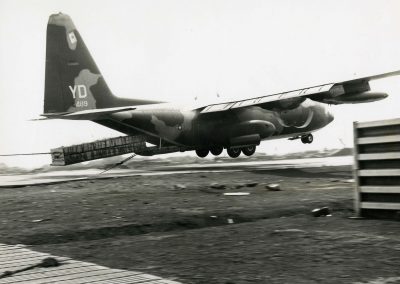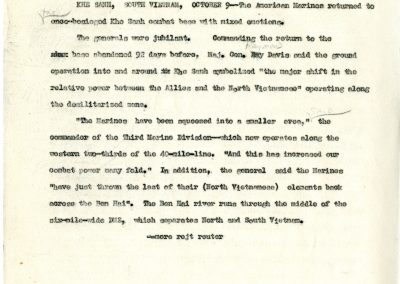Journalism in Action: Beverly Deepe Keever and Her Career
Archives & Special Collections, University of Nebraska-LincolnKhe Sanh
by Sam Mellema
Tucked away in the north-west corner of South Vietnam hid the small village of Khe Sanh. Although not a large settlement, Khe Sanh had great military importance for the United States because of its strategic location. Khe Sanh lay only a few miles from the DMZ (Demilitarized Zone), a few miles from the border with Laos, and within close proximity to the Ho Chi Minh Trail. For these reasons, the United States saw the strategic value of the area, established a base just a few miles from Khe Sanh, and aptly named it Khe Sanh Base.
In early 1968, North Vietnamese troops attacked Khe Sanh and the surrounding countryside. The Communists aimed to eliminate the American presence in the region and take control of the critical outpost; and so began the infamous Siege of Khe Sanh. Lasting a brutal 77 days, the Battle of Khe Sanh forged itself into the history books as one of the most brutal battles of the entire war.
For several months between January and April 1968, the North Vietnamese Army (NVA) squared off with the allied forces of the United States Marine Corps (USMC) and the Army of the Republic of Vietnam (ARVN). NVA troops surrounded allied forces at both the base and at surrounding hilltops, a critical U.S. vulnerability. The NVA used guerrilla tactics, mortar, and artillery bombardments to pound the better equipped, well trained Americans and South Vietnamese. These tactics proved fairly effective as the battle progressed. NVA mortar shelling and sniping made it difficult for Americans to deliver fresh supplies and troops to the relatively small fortress. As the battle progressed, planes and support helicopters would seldom, and eventually never, land at the base; rather they would keep flying and parachute drop supplies into the base. If planes and helicopters did land in the base, they would provide an easy target for Communist forces to shoot down. Some veterans of the battle noted that NVA troops allowed airplanes to drop some supplies to the Americans and South Vietnamese when they could have just as easily shot them down. It seemed as if the North Vietnamese simply allowed the Americans to hold the base. It may have been possible that the NVA used Khe Sanh as a distraction to the Americans while the Viet Cong and North Vietnamese planned and implemented the Tet Offensive.
The NVA had the ability to approach the American and South Vietnamese troops at Khe Sanh at terrifyingly close distances. In 1962, US Army Special Forces built Khe Sanh on top of an elaborate tunnel system that ran throughout the entire mountain. NVA spent their nights digging closer and closer to these tunnels. If the NVA troops could break into just one of these tunnels, it could spell disaster for the Marines holding the fortress. To prevent the NVA from breaking into the base, American troops would bomb the surrounding area into oblivion. In just 77 days, American bombers dropped more than 14,000 tons of bombs in the surrounding countryside in Operation Niagara. Commander of American troops in Vietnam William Westmoreland even suggested using a nuclear bomb to completely wipe out the enemy.
President Lyndon B. Johnson and other American commanders determined to hold the base at all costs. Allied leaders understood the importance of Khe Sanh. They believed that if Khe Sanh fell, NVA troops could have a foothold in South Vietnam and the Ho Chi Minh Trail would have easier access to funnel troops and supplies into the South. President Johnson obsessed so much over the base, he installed a sandbox model in the White House.
By the end of the siege, US troops killed a large number of North Vietnamese troops, but as in almost every battle or skirmish in Vietnam, the NVA did not intend to get the highest kill count, rather the NVA aimed to hold ground and secure tactical victories instead of numerical ones. American troops had their supplies stretched so thin that they eventually had to abandon the outpost. The retreat began in April and American and South Vietnamese troops had completely left the Khe Sanh area in just a few days.
Beverly Deepe Keever got the opportunity to visit Khe Sanh during the battle itself. Keever recounts in her book Death Zones and Darling Spies her experience of reporting such a dangerous and influential event in the Vietnam War. Journalists in Khe Sanh got almost completely free rein on what they could report, photograph, or who to interview. Keever got the chance to go wherever she wanted in the base and she also got to interview all kinds of personnel; from the lowest ranking South Vietnamese troops all the way up to the top command for American troops. Keever eventually wrote a series of articles for the Christian Science Monitor on the Battle of Khe Sanh. The series was nominated for a Pulitzer Prize in 1969.
Cargo Delivery
The trailing hook of a C-130 Hercules cargo load catches on the arresting cable that stretches across the Khe Sanh runway. The new cargo deilvery technique, called Ground Proximity Extraction System, decreases the air crafts exposure time to hostile fire.
Revisiting Khe Sanh- Rough Draft of Article
“K/S” Article (written w/ normass) on marines returning to the Khe Sanh outpost, 1



